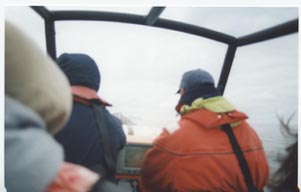
On board the rib with our captain, Murdo.
St Kilda
Occasionally and depending on weather it is possible to have a day trip
to St Kilda archipeligo which lies about 50 miles west of North Uist
I travelled on a rib on a fairly calm day with Sea Trek who are based
in Lewis but sailed from Berneray.
This isolated island group is all that remains above the sea of
a large volcano thought to have been active about 60 million years ago.
The underlying rocks - granite, gabbro and dolerite – have been eroded
by ice, rain and sea to form an impressive coastline to all four main islands
and their offshore stacks. Hirta boasts the highest sea cliff in
the British Isles at Conachair (430 metres), and Stac an Armin (191 metres)
is the highest sea stack.
People were living on Hirta, the largest of the St Kilda islands,
some 2000 years ago. Human occupation of these 'islands on the edge of
the world' - the remotest community in Britain - continued more or less
without interruption until 1930. That year the remaining 36 inhabitants
were evacuated at their own request, the isolation - especially in winter
- proving too much for their unique hut fragile way of life.
The huge numbers of seabirds were vital to the islanders survival .
Birds eggs provided fresh food in the summer - alongside mutton and fish
- with gannets
and fulmars being harvested each season to be plucked, dried and stored
for the winter. Feathers and oil were kept for export and helped
pay the rent, whilst bones were shaped into useful implements and skins
into shoes.
The extreme isolation of St Kilda means that only a limited range of
plants and animals can survive here. For instance, of the 367 butterflies
and moths recorded from
the Western Isles, only 58 have occurred on St Kilda. However, many
of the animals that do live on the islands either exist in verv large numbers
or have taken on a unique character.
The familiar wren that we know from hedgerows and gardens, lives on
St Kilda amongst- the bleak ruins of Hirta or on the steep, inhospitable
cliffs. But it is larger and less streaky than it's mainland relative,
and its powerful song provides an unexpected backdrop to the crash of Atlantic
waves. Wrens are even known to breed on some of the remote rock stacks.
The mice of St Kilda also differ from mainland populations. The distinctivehouse
mouse became extinct immediately after the islanders departed, but the
field mice – less dependent upon humans -still thrive. A flock of
primitive sheep, found nowhere else in the world survived on the isolated
island of Soay. After the evacuation some were transferred from Soay to
Hirta where they now run completely unmanaged. An unusual form of Blackface
sheep also remains marooned on Boreray.
Scottish Natural Heritage supports a programme of wildlife research and
survey on the islands, whichincludes a long-term study of the Soay sheep,
continual monitoring of the seabird populations and detailed vegetation
mapping. The remarkable buildings and archaeological remains are scheduled
ancient monuments and are actively conserved by volunteer parties of
the National Trust for Scotland. SNH and the NTS employ a warden on Hirta
throughout the summer months.

On board the rib with our captain, Murdo.

en route to St Kilda, you can get this view from Uist at Hosta, Clettreval
or Scolpaig.
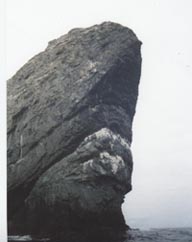
Stac Lee
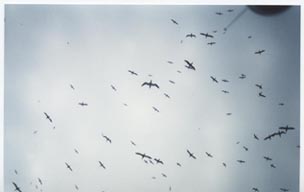
Gannets overhead, some 60,000 pairs on Boreray and stacks.Also 62,000
pairs of fulmars and 140,000 pairs of puffins!
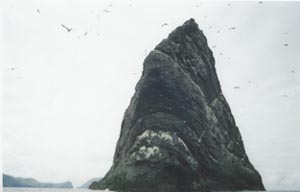
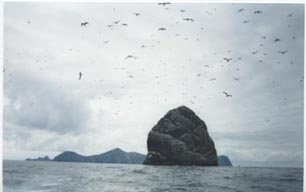
Stac an Armin
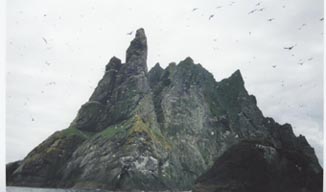
Boreray
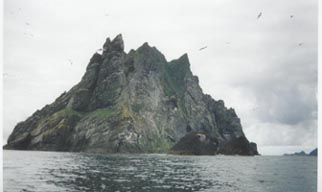
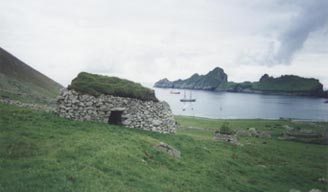
Cleit, more than a thousand on island. Primitive storehouses used by
islanders to dry and store peat, nets, corn , birds, meat,fish and eggs.
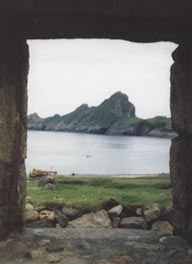
Village Bay from the main village street
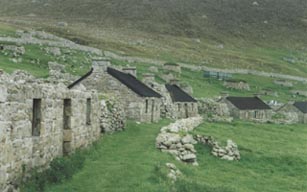
Village Street, cottages built in the 1860s with money raised in Glasgow
by the Rev.Neil Mackenzie. Have faced stonework but thin walls in comparison
to the Blackhouses (1834). The cottage doors and windows face the prevailing
wind - walls were built in front to act as windbreaks.
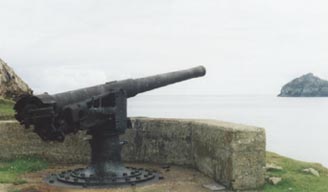
Gun and magazine store placed here in 1918 after a German U-boat shelled
the village to destroy a radio mast.
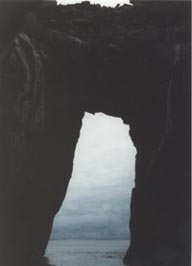
Arch at Seilg Geo
Recommended reading - St Kilda - Island on the Edge of the World - Charles Maclean.